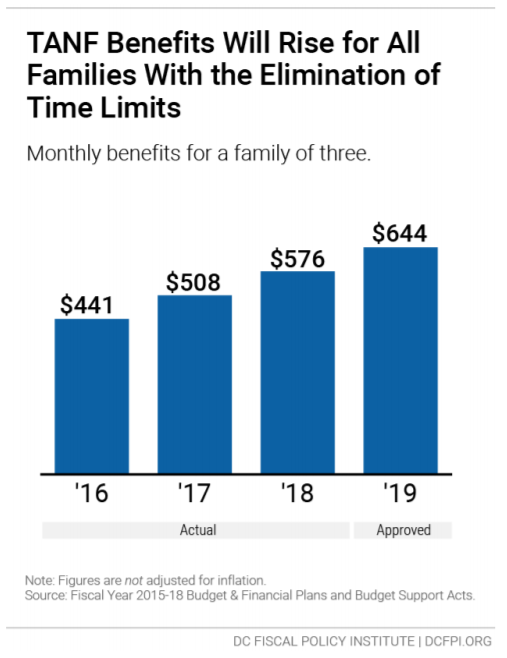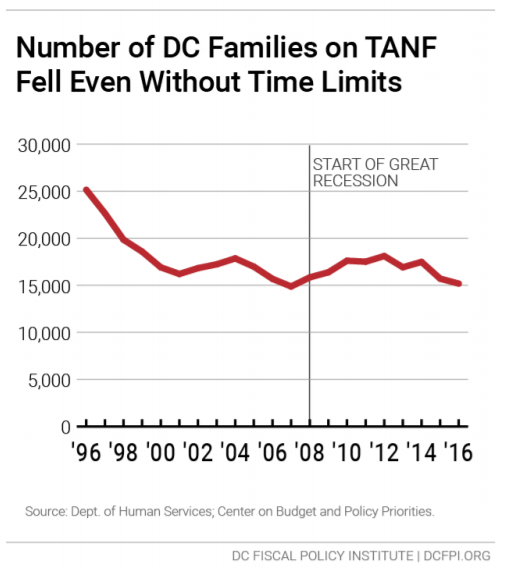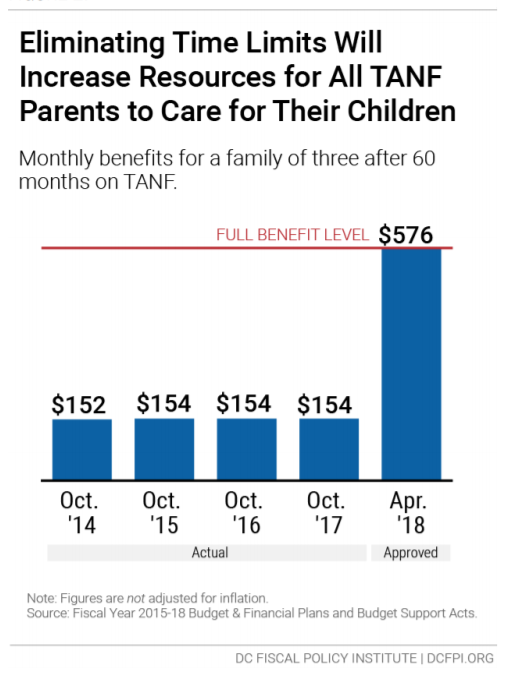The fiscal year (FY) 2018 budget reforms DC’s TANF program by resolving long-standing concerns with the District’s rigid 60-month time limit, a problem that has confounded the District for years. The adopted budget allocates $10.3 million to protect DC’s most vulnerable children and prevent approximately 6,000 DC families— including over 10,000 children—from permanently losing their TANF benefits due to the District’s time limit, which was set to occur on October 1, 2017.
Under the adopted budget, which is largely based on recommendations of a working group established by the Bowser administration in 2016,
families are no longer be at risk of permanently losing their TANF benefits once they have exceeded 60 months of benefits in their lifetime; all families facing economic hardship will continue to receive some level of income assistance to meet their children’s basic needs, along with subsidized childcare and employment services, regardless of whether they have received TANF benefits for 60 months or longer.
Additionally, the FY 2018 budget limits the amount that a family’s monthly TANF benefit can be cut or reduced by sanctions due to parental non-compliance with TANF work activity requirements. This is meant to protect children within the family, by ensuring a basic level of income each month in order to cover their basic needs, regardless of whether parents are in full compliance.
The budget adopts the working group recommendation that 80 percent of a family’s TANF benefit would be considered the child portion that cannot be cut for any reason. The remaining 20 percent is considered the parent’s portion and can be subject to sanction for this reason. Under the approved FY 2018 budget, 30 percent of the parent’s portion can be cut if a parent is not complying with TANF work participation requirements. This means that for a family of three receiving the full TANF benefit of $576 (as of April 2018), the maximum sanction for parental non-compliance is just under $35.
This 80/20 split was recommended by the working group in order to protect children from suffering economic hardship due to factors out of their control, such as a parent not complying with TANF rules, while still maintaining some level of sanction for parents.
The FY 2018 budget also preserves increases in TANF benefits adopted in the FY 2015 budget and then modified in FY 2016 to alter the timeline for implementation. Under these changes, the maximum benefit for a family of three will increase from $508 a month in FY 2017 to $576 in FY 2018 and $644 by FY 2019, which is more in line with benefits in other high-cost jurisdictions (Figure 1).

Background on TANF and DC’s TANF Time Limit
The District’s Temporary Assistance for Needy Families (TANF) program provides cash assistance, subsidized childcare, and employment
resources to help families with children facing economic hardship. The program, operated by the Department of Human Services (DHS), is funded with a mix of federal and local funds.
Prior to 2011, the District of Columbia did not implement a TANF time limit, in full compliance with federal law, which grants states and DC the flexibility to design and implement their own time limit policies.
Even without a time limit, the number of DC families receiving TANF assistance today— approximately 16,000—is one-third lower than in
1996, when federal welfare reform legislation was adopted. Although the argument for time limits has always been that they encourage selfsufficiency and prevent low-income parents from relying on government assistance, the data on DC’s caseload indicate otherwise. The District’s TANF caseload fell through 2008—with a modest temporary increase during the recession of the early 2000s—even though the city did not have TANF time limits in place; the eligibility criteria to obtain TANF did not become more restrictive during this time either.
The fact that DC’s TANF caseloads fell up until the Great Recession instead suggests that receipt of TANF assistance is tied to the strength of the economy and job opportunities; parents find gainful employment on their own and leave TANF when the economy is growing and provides job opportunities. Predictably, the number of families receiving TANF rose during the Great Recession that started in 2008, but the total caseload remained well below the 1996 level (Figure 2).
Although the District’s TANF caseload fell significantly without a time limit, District policymakers chose in 2011 to establish a 60-month time limit. Under that policy, any family that had received assistance for more than 60 months in their lifetime faced an immediate reduction in cash assistance benefits. The policy called for reducing benefits further in subsequent years and eliminated benefits entirely for 60-month recipients starting in FY 2015.
The time limit policy, which was essentially eliminated by the FY 2018 budget, resulted in substantial cuts to TANF benefits—a family of three that has received aid more than 60 months currently (FY 2017) receives just $154 in assistance each month. The policy to fully eliminate benefits was never implemented out of concern that it would create significant hardship. Instead in both FY 2016 and FY 2017, the mayor and DC Council chose to extend benefits at this low level.
In 2016, Mayor Bowser convened a working group within the Department of Human Services to develop a permanent policy to replace DC’s existing TANF time limit.

New Reform to Time Limit Will Protect Children
The new TANF time limit policy adopted by the FY 2018 budget will be implemented in April 2018 and ensures that parents facing economic
hardship have consistent income and resources to meet their children’s basic needs, such as socks, diapers or a winter coat.
The TANF reforms are the result of a working group convened by Mayor Bowser’s Department of Human Services in 2016. The working group was informed by a significant body of research, as well as information from national leading experts on the importance of economic stability for the wellbeing and health of children. That research shows that instability and extreme poverty increase the likelihood of problems in school, chronic health conditions, and other negative outcomes. In addition, the working group recognized that a cut-off of income assistance could contribute to increases in families experiencing homelessness, child welfare referrals, and other social services.
The new policy will mean a substantial increase in benefits for the nearly 6,000 DC families who have been on TANF 60 months or longer and were scheduled for cut-off in October 2017. These families have received extremely meager cash benefits since 2014; the current benefit for a family of three over 60 months is just $154 per month. Benefits for these families will increase to $576 a month when the new policy goes into effect in April 2018 (Figure 3).

Why Addressing the Time Limit Was Important
The District’s TANF time limit policy posed a critical challenge to DC officials, advocates,
service providers and TANF recipients themselves since it was adopted in 2011. The proposed FY18 budget’s TANF time limit reform
would address one of the most critical social policy issues affecting the well-being of low-income children that the District has seen in years, by removing time limits and prioritizing the well-being of children.
The District’s new time limit policy is a sound approach that will help improve the outcomes of low-income families, especially their children.
Strict time limits often push vulnerable families deeper into poverty, with devastating consequences for children, based on research on
time limits in many states. This research finds that the vast majority of families cut off TANF are not able to replace lost benefits with employment income, leaving many to lead chaotic and unstable lives. This leads to increases in homelessness and child neglect as families cannot meet their children’s most basic needs. Current economic conditions in the District would have exacerbated these issues observed nationwide, given the high rate of homelessness, lack of affordable housing, and extreme economic and racial disparities in the District.
Recent research also has revealed more about the characteristics of families who stay on TANF long term, for over 60 months. This research confirms that families reaching time limits often have substantial problems, including high rates of mental illness, domestic violence, and disabilities. A recent survey of long-term TANF recipients in the District found that roughly 40 percent had a physical health issue and over 30 percent had depression or anxiety severe enough to prevent them from participating in meaningful work activities.
In contrast, policies that help stabilize the incomes of low-income families have long-lasting positive effects on a child’s ability to succeed in school, get a high school or college degree, and find work as an adult.
Budget Maintains Planned Increases in Cash Assistance
The FY 2018 budget maintains a three-year plan to increase TANF benefits substantially from 2017 through 2019, with annual inflation
adjustments after that. As a result, monthly benefits for a family of three will increase to $576 in FY 2018. By FY 2019, the maximum benefit for a family of three will be $644 a month, compared with $441 in FY 2016 (Table 1). The increase in benefits now scheduled for fiscal years
2017-2019 will put DC’s benefits in line with benefits in other high-cost jurisdictions such as Boston ($618), Los Angeles ($704), and New York City ($789). Even with the increase, however, cash benefits will be only at 36 percent of the poverty line in FY 2019.

